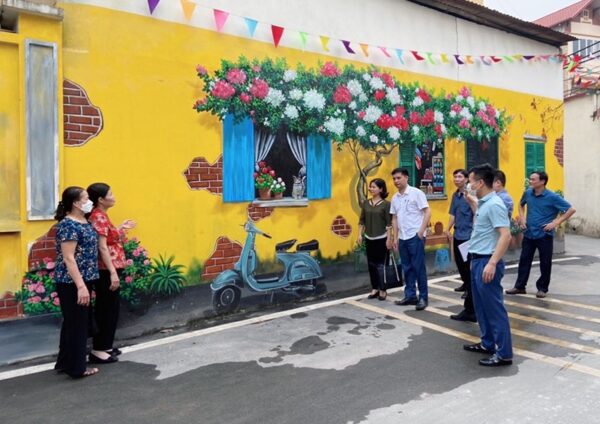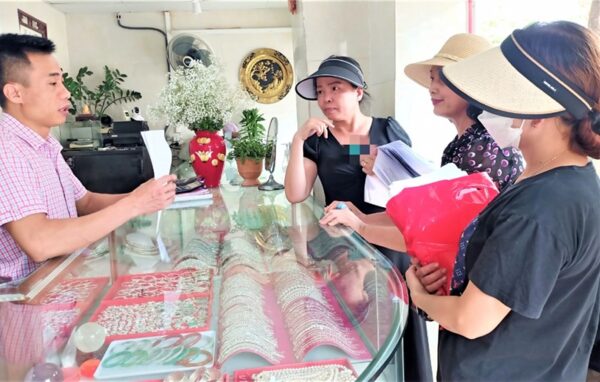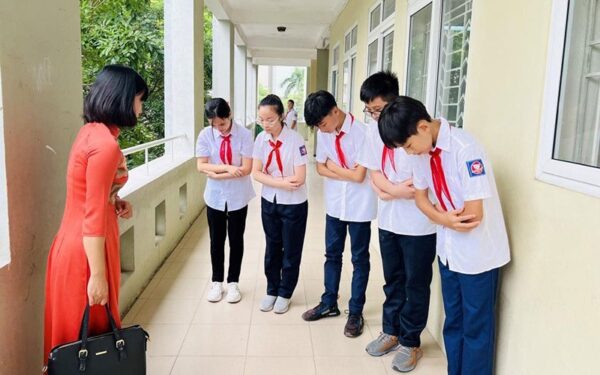After over six years of implementation, the Code of Public Conduct in public areas in Hanoi has engendered positive shifts in the community’s behavioral culture. This achievement results from the diversification of communication methods, parallel campaigns, and the replication of successful practices and exemplary models.
To sustain these accomplishments and continually enhance the quality of implementing the Code of Public Conduct in public areas, on December 27, 2021, the People’s Committee of Hanoi issued a plan for Code of Public Conduct implementation in the city for the 2021-2025 period. The plan aims to progressively establish and cultivate cultural standards to regulate the speech, attitudes, and behavior of individuals and organizations in public areas throughout the city. This aligns with the standards of cultivating an elegant and refined population of Hanoi, contributing to preserving and developing the capital’s and the country’s rich cultural traditions.
Enhancing the Effectiveness of Propagation of Code of Public Conduct in Public Areas
By 2025, the city calls on its departments, bureaus, and municipal authorities, as well as the People’s Committees of districts, suburban areas, and towns, to intensify Code of Public Conduct dissemination through diverse means. This includes publicizing information through mass media, mobile campaigns, organizing competitions, creative camps, conferences, seminars, flag-raising ceremonies, and education in the school system. The plan also suggests tailoring appropriate communication solutions for specific target groups. Emphasis will be placed on the role of leaders in agencies, units, enterprises, influential elderly individuals, and those with reputations that impact community behavior as exemplary models of Code of Public Conduct adherence. Efforts will concentrate on disseminating information in crowded areas where breaches of standards are more likely to occur, such as markets, shopping centers, cinemas, cultural houses, bus stations, flower gardens, parks, and cultural and sports spaces within communities. Simultaneously, there will be an intensified focus on disseminating information about the culture and conduct of citizens participating in traffic. The posting of Code of Public Conduct guidelines at the headquarters of People’s Committees in communes, wards, townships, cultural houses in villages, hamlets, residential areas, historical sites, and public areas must adhere to a unified city-wide template, replacing outdated, discolored propaganda boards that fail to ensure effective communication.

The model for building hamlets and residential groups free of social vices with bright, green, clean, and beautiful environments has been successfully proliferated across various regions.
Simultaneously, the endeavor to enhance the quality of implementing the Code of Public Conduct in public areas must be tightly integrated with the effective implementation of democratic regulations at the grassroots level. This involves adhering to conventions and voluntary commitments. Scrutinizing these conventions, and commitments, and incorporating the content of the Code of Public Conduct into the conventions and commitments of each hamlet, village, and group for transparent and effective implementation at each unit is imperative. The vigorous promotion of Code of Public Conduct conventions, commitments, and adherence aims to strengthen educational awareness regarding compliance, shape societal opinions, and regulate the behavior of individuals. Cultivating a sense of legal respect and practicing conventions, commitments, and the Code of Public Conduct should become a beautiful way of life across all segments of the population. Emphasis should be placed on the quality of upholding civilized living standards in marriage, funeral ceremonies, and the organization of traditional festivals at the local level. Integrating the implementation of the Code of Public Conduct in public areas with the execution of the Code of Public Conduct by officials, civil servants, and workers in City-affiliated agencies, especially the exemplary conduct of the administrative workforce, is essential. Investing in infrastructure, perfecting urban facilities by adding waste bins, sanitation facilities, street lighting, and constructing an aesthetically pleasing urban environmental landscape are crucial steps. These endeavors aim to minimize violations, ensuring the practice of cultural, civilized living, and a Code of Public Conduct in public areas. Strictly addressing and rectifying instances of violating urban regulations, encroaching upon roadways, and occupying sidewalks for commercial purposes is crucial. Organizing and restructuring the order of sidewalks and streets to ensure accessibility is a key step toward constructing pedestrian-friendly routes and streets.
Replicating Exemplary Models
After 5 years of implementation, the Code of Public Conduct in Hanoi has engendered positive transformations in the community’s behavioral culture. This success stems from diversifying forms of communication, synchronized engagement with innovation, and amplifying commendable practices and exemplary models. Harnessing the palpable effectiveness, the capital’s cultural sector is actively disseminating commendable practices to enhance the quality of Code of Public Conduct implementation in public areas. These include Cultural Apartment models, courteous behavior, respect for communal spaces without encroaching upon personal domains, and models such as the People and Small Businesses of the Ancient Town, being tourist-friendly without solicitation, price hikes, or pressuring tourists into services. The models extend to friendly communication by small traders during the purchase and sale of goods, transparent pricing, and disclosing product origins without employing harmful chemicals. Additional models involve guiding citizens to adhere to traffic laws, promoting friendliness, and exhibiting tolerance in the event of road collisions. Noteworthy are models pertaining to villages and neighborhoods free from social vices, fostering bright, green, clean, and beautiful environments, as well as models led by volunteer students advocating for friendly tourism. Models involving historical-cultural sites as safe and appealing destinations, exemplary cultural villages, and standardized urban civilized wards, have also gained prominence.

Small businesses sign a commitment to implement the Code of Civilized Conduct in the market. Photo: laodongthudo.vn
Particularly, the establishment of “Civilized Markets” is a model actively promoted by the Hanoi Women’s Union in conjunction with the implementation of the Code of Public Conduct in public areas. At Thai Ha Market, one of the traditional markets in Dong Da District, Hanoi has undergone significant changes. Disorderly displays, encroachment into common pathways, and street vending practices have been eradicated. The market space is now airy, waste is meticulously cleared, and cleanliness prevails. In implementing the “Civilized Market” model, businesses and small traders at Thai Ha Market commit to upholding the Code of Public Conduct with actions such as transparent pricing, providing and exchanging information, proper communication, queuing during transactions, and using environmentally friendly packaging. Undesirable actions include trading in counterfeit or low-quality goods, dishonest speech or deceptive practices, causing disturbances to public order, and engaging in transactions beyond prescribed limits. By diligently adhering to the City’s Code of Public Conduct, businesses and small traders contribute step by step to the establishment of cultural standards, preserving and developing the capital’s rich traditions.
In addition to the models implemented by the city, various districts and towns have developed their own models that have yielded remarkably positive results. In the execution of the Code of Public Conduct, Long Bien District has seen the formulation of numerous models and initiatives by civic organizations such as the Fatherland Front, Labor Union, Women’s Union, and Youth Union. Particularly noteworthy is the ongoing initiative by the Education sector in Long Bien District known as the “Bright, Green, Clean, Beautiful School,” which has evolved into the “Bright, Green, Clean, Beautiful, Civilized School” over the years. In 2022, the district introduced the additional criterion of “Happiness.” Also in 2022, Long Bien District expanded the implementation of the “Culture of Greetings,” previously initiated at Viet Hung Urban Secondary School, to all preschools, primary schools, and secondary schools. The act of “Folded hands – Smiles – Greetings” has become a charming aspect of communication culture proliferating among students and teachers in schools across Long Bien District.

The model “Teachers and Students of Gia Thuy Secondary School practicing greeting culture inside and outside the school” has been replicated throughout Long Bien district.
According to Mr. Bui Minh Hoang, Head of the Division of Cultural and Family Life Development (Hanoi Department of Culture and Sports), arousing a sense of responsibility in every individual towards their living and working environment is a crucial goal in building and replicating Code of Public Conduct models. This, in turn, enhances the quality of cultural life at the grassroots level. Beyond simply promoting and guiding the implementation of these models, localities must consistently encourage and provide incentive policies to ensure the longevity and genuine effectiveness of these models in shaping and cultivating behavioral culture within the community.
Thuy Nga

